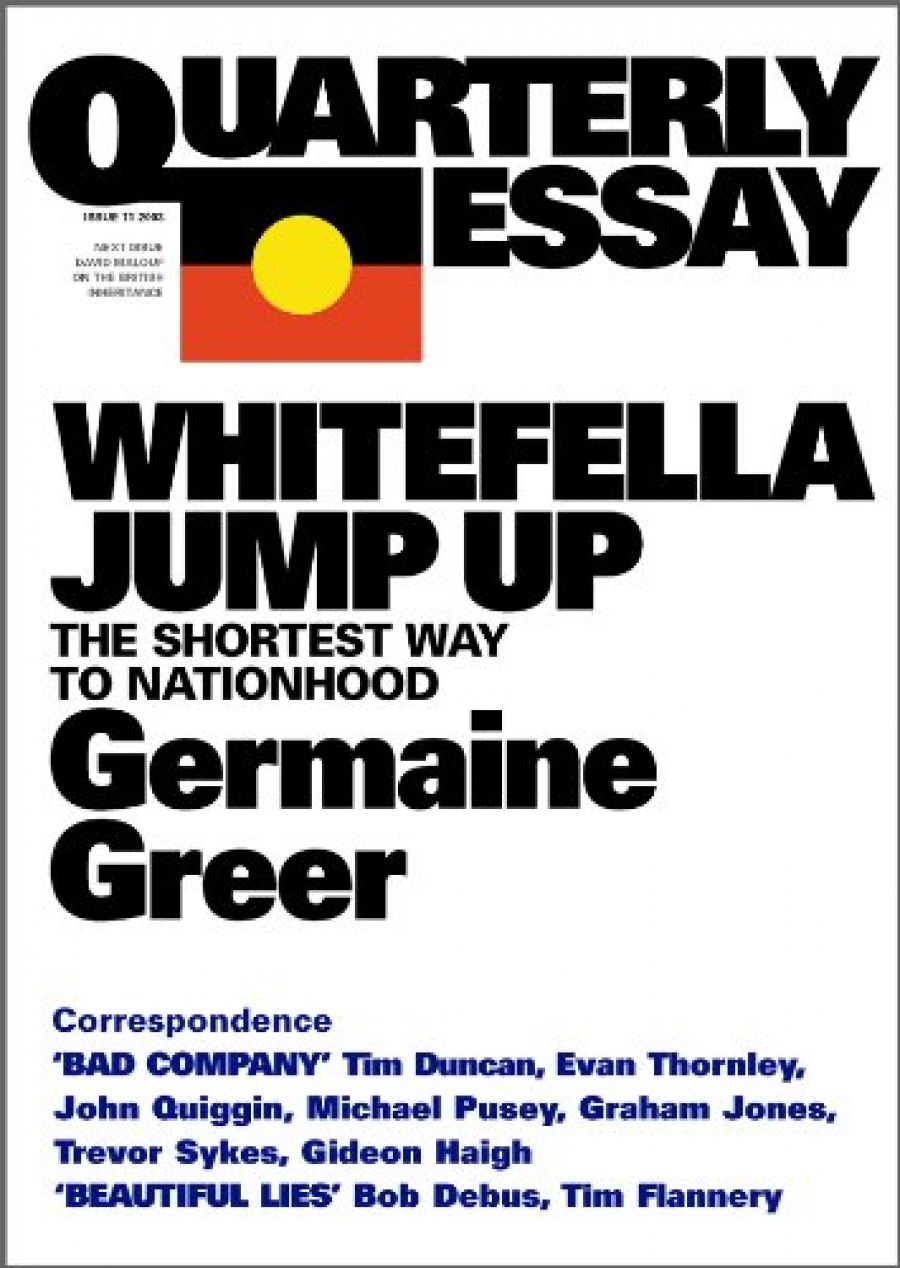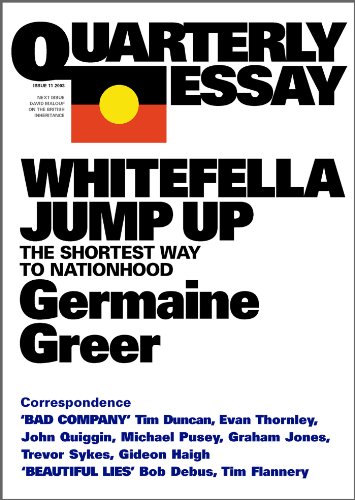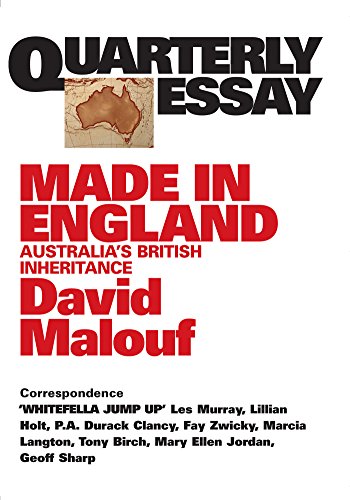
- Free Article: No
- Contents Category: Journal
- Review Article: Yes
- Article Title: Mind hoards
- Online Only: No
- Custom Highlight Text:
Peter Craven calls up an echo of W.B. Yeats’s ‘The Circus Animals’ Desertion’ at the conclusion of his introduction to Germaine Greer’s highly charged and instantly controversial essay Whitefella Jump Up. ‘It is an essay about sitting down and thinking where all the politics start,’ he writes.
- Book 1 Title: Whitefella Jump Up
- Book 1 Subtitle: The shortest way to nationhood (Quarterly Essay 11)
- Book 1 Biblio: Black Inc., $12.95pb, 120pp
- Book 1 Cover Small (400 x 600):

- Book 1 Cover (800 x 1200):

- Book 2 Title: Made In England
- Book 2 Subtitle: Australia’s British inheritance (Quarterly Essay 12)
- Book 2 Biblio: Black Inc., $12.95pb, 100pp
- Book 2 Cover Small (400 x 600):

- Book 2 Cover (800 x 1200):

Craven was writing, I gather, before he had seen the text of David Malouf’s succeeding quarterly essay in this now essential Black Inc. series. With Greer proposing that white Australians embrace Aboriginality, that ‘the gubba move towards the blackfella’, and with Malouf working to the title Made in England: Australia’s British Inheritance, Craven must have been expecting, at best, a frisson of dissonance. But the gods had more in mind. The two essays, about as different as can be in cadence and argument, nonetheless intersect, sometimes run parallel. Malouf, like Greer, is engaged in a radical exploration of the way Australians understand themselves and their history, and in a language alive to depths of thought and feeling, not just the surface reflexes of nationalism. In the ripples of deep thought, the writers overlap.
Here is a crucial passage, one that links the two essays, from Malouf’s chapter called ‘Homeland’. Malouf has been quoting Vance Palmer, from a March 1942 essay in Meanjin Papers: ‘The next few months may decide not only whether we are to survive, but whether we deserve to survive.’ What Palmer in 1942 would preserve, and fight for, is ‘an Australia of the spirit, submerged and not very articulate, that is quite different from these baubles of old-world imperialism’. And Malouf’s gloss on Palmer:
What had changed under the threat of imminent invasion was the willingness … to take a hard look at what Australia actually was, free of the usual swagger and whistling in the dark, and to accept the challenge to get below the surface. To penetrate the soil of Australia, as Palmer puts it, ‘with love and imagination’; to give that submerged and inarticulate spirit voice.
With love and imagination, and in a language always seeking the concrete image, the metaphorical as well as the argumentative logic, Malouf continues:
The threat of the invasion, and the arrival of the Americans to save us, did not break our tie with Britain, or make it inevitable that we would one day become a minor constellation of the Stars and Stripes. What it did was bring Australia – the land itself – fully alive at last in our consciousness. As part of the earth of which we were now the custodians. As soil to be defended and preserved because we were deeply connected to it. As the one place where we were properly at home, the one place to which we were related in an interior way by daily experience … and which related us, in a way we were just beginning to grasp, to those for whom the land of Australia had always been this: the people we thought we had dispossessed but who had always ‘owned’ the place in a way we were just beginning to appreciate.
There is the hinge between Malouf’s quiet, accretive view of Australia, ‘free of the usual swagger and the whistling in the dark’, and Germaine Greer’s imagined, new, turned-upside-down place where Australians might ‘recognise their own Aboriginality’. Both writers, in their utterly different ways, want the same thing: an Australia fully alive in our consciousness, a place seen, in Malouf’s words, ‘through eyes that had experienced the business of seeing only here, in the light as it falls on this place only’. And both, in a manner that would have delighted Michel de Montaigne, use the essay form to elaborate a conversation between self and the world. Some of the criticism that Greer has drawn (instance the Sunday Age: ‘The Great Dingbat Has Spoken’) mistakes the protean function of the essay. Certainly, she comes closer than Malouf to Montaigne’s confession: ‘I am myself the matter of my book.’ But both essays, indelibly marked by the distinctive voice and habit of mind of their writers, are also essentially exploratory, not definitive, not prescriptive. Greer: ‘Disagree with me by all means, dear reader, but don’t dismiss me out of hand. Sit on the ground with me. Think.’ And Malouf:
This venture we call ‘Australia’ was always an experiment. It has taken us a long time to see it in this light, and even longer to accept the lightness, the freedom, the possibility that offers as a way of being. It keeps us on our toes, as curious observers of ourselves. It has made us value quick reflexes and improvisation – lightness in that sense too. It ought to make us sceptical of conclusions, of any belief that where we are now is more than a moment along the way. An experiment is open, all conclusions provisional.
So there is the connection, and an essay editor’s grace – the sparks that generate when different ideas rub along together.
Quick reflexes and improvisation – Malouf’s terms – have always been part of Germaine Greer’s stock-in-trade. Read as a shrewd improvisation, a vehement ‘what if’, Whitefella Jump Up does what is needed in our present cultural impasse: it jump-starts the stalled debate about black and white relations. What if we Australians acknowledged how intimately connected black and white are? What if we stopped corralling (and thus failing to solve) the Aboriginal ‘problem’? What if we abandoned the fraught debate over whose land it is and stopped trying to give back what is not ‘ours to give’? What if we admitted ‘it has been an Aboriginal country all along’?
Utopian? Certainly. And much of what Greer envisions will almost certainly not happen. But Australia itself, the place Malouf conjures, the place of lightness, of freedom, must have seemed unimaginable to those doing penance on hulks or in the slavery, formal and informal, of Europe’s social toils.
In essaying a possibility, Greer prompts other voices to chime in, encouraged, or goaded, by the substance of her proposal. Thus Les Murray:
One side of Dr Greer’s new manifesto Whitefella Jump Up that strongly appeals to me is its subtle understanding of what for a generation I have been calling convergence, the slow mutual assimilation of Aborigines and other Australians. She understands the dynamics of this, how it is both genetic and cultural, and how truly equal it has been, despite all the efforts, earlier and recent, to hide and deny it.
Murray writes in the extensive ‘Correspondence’ section (on Greer, and a piquant epilogue to Malouf’s essay) that is another boon of this Black Inc. series. His contribution is characteristic, both of Murray himself and of the nature of the critical enterprise at its best. He is sharp (‘Dr Greer’s new manifesto’) but generous, as intelligence can be. If he goes on to dismiss the rest of Greer’s case as reflecting ‘the mythology of the Skippy left’, he first finds common cause – rare now, when polarised opinion and mutual exclusions are the norm. Other more critical responses keep in the vein. Marcia Langton is severe: ‘The greatest weakness of Germaine Greer’s essay is its zany disconnectedness. Aboriginal societies were pushed to the brink of extinction, and yet the evidence for the Aboriginal influence on Australian culture is valorised.’ But, Langton continues: ‘[I]t is at least a vision that does not spring from hate.’
Other correspondents find flaws, but all engage, all take Greer’s ‘modest suggestion’ and do something lithe and subtle with it. Which is, after all, what she wanted.
Malouf begins his analysis of our fundamental British inheritance, the English language, in Washington, in the vaults of the Folger Library. It’s a beguiling prologue and a politically complex opening move in an essay of exemplary subtlety and vividness. Here we are with him in a hoard as glittering as any ever guarded by a dragon. A mind hoard. Quarto and folio editions of Shakespeare, relics of Pope, Dr Johnson, prompt copies used by Garrick and Kean. And more, more. But this is Washington, not London. The language has colonised to greater effect than has any monarch. And the language and its entails are what sets Malouf off: ‘All this, hovering in the air in those humming vaults on that peaceful afternoon in the midst of what was still an unfinished war, was the beginning of what I am writing here.’
What Malouf writes is a novelist’s essay, one which works by accumulation of vivid detail and equally vivid insight. His Brisbane childhood is the place where habits of mind and observation are laid down – rich, layered evidence for his case about language as the inheritance that both fixes us and allows us to move. Malouf works in his own analytic terms, as it were, with the metaphorical impulse inherited from Shakespeare, capable at once of thought and feeling, but also through the language of the English and Scottish Enlightenment, ‘sober, unemphatic, good-humoured’. It is that Enlightenment inheritance, so goes Malouf’s argument, that differentiates Australia from the US, founded as it was earlier, at a time when English was ‘passionately evangelical and utopian … the language of … religious dissenters of the early seventeenth century who left England to be free, as they saw it’. (It’s hard to resist a brief, irreverent vision of Greer as the Jacobean dissenter, dramatic and insistent in the rhythms of her rhetoric, and Malouf as the Enlightenment rationalist and descendant of David Hume. Alas, too simple.)
There is an argument to be had with Malouf about cause. Crudely reduced, it will go something like this: have we been made by our language? Did Australia evolve its arbitration systems, for example, because we were children of the Enlightenment? But it will be a good argument to have, and Malouf’s answers, as they are laid out here in this infinitely rich account of Australian history, speech and social ways, are a deft and instructive rebuttal of any reductive, self-interested assertions about identity and nationality. He can do Paul Keating’s Morphy Richards rhetorical trick, but so much more besides. His essay is a compendium of ways of thinking about who we are and how we got to be that way – the kind of identity treasure hunt we have to have, with nothing lost, nothing denied, nothing abandoned. And with the next move anticipated, not foreclosed.


Comments powered by CComment